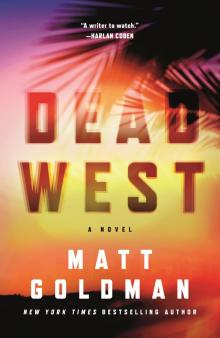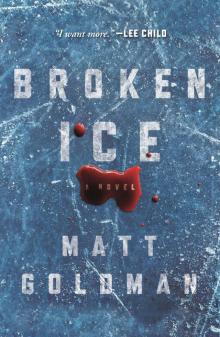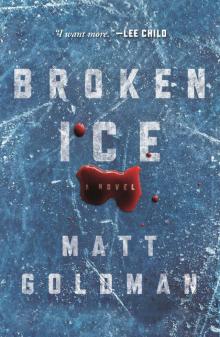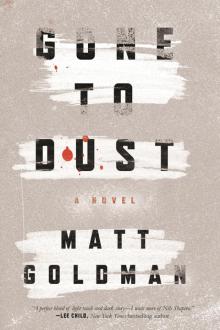- Home
- Matt Goldman
Broken Ice--A Novel
Broken Ice--A Novel Read online
Begin Reading
Table of Contents
About the Author
Copyright Page
Thank you for buying this
Tom Doherty Associates ebook.
To receive special offers, bonus content,
and info on new releases and other great reads,
sign up for our newsletters.
Or visit us online at
us.macmillan.com/newslettersignup
For email updates on the author, click here.
The author and publisher have provided this e-book to you without Digital Rights Management software (DRM) applied so that you can enjoy reading it on your personal devices. This e-book is for your personal use only. You may not print or post this e-book, or make this e-book publicly available in any way. You may not copy, reproduce, or upload this e-book, other than to read it on one of your personal devices.
Copyright infringement is against the law. If you believe the copy of this e-book you are reading infringes on the author’s copyright, please notify the publisher at: us.macmillanusa.com/piracy.
For my mother, Helen, who put a book in my hands whenever I set down my baseball mitt.
1
I saw Roger Engstrom three times—the second two he was dead. But the first time he sat on a tufted leather chair in the Saint Paul Hotel’s Harold Stassen Suite with a Yorkshire terrier on his lap. The dog was the result of neither intelligent design nor natural selection. Man created the Yorkshire terrier, and Man had made a terrible mistake. If your full-grown dog fits in a bag designed to carry keys and a wallet, it’s not a dog you’re toting around—it’s an accessory.
Roger had curly blond hair threaded with silver, was tall and lean except for a soft belly that hung over his belt. He wore a navy long-sleeved polo tucked into khaki pants that rode up his legs revealing socks festooned with images of computer chips. Duck boots covered his feet, protection from Minnesota’s March slush.
He scratched between the little creature’s ears and said, “Thank you for seeing us on short notice, Nils.” His voice was high-pitched and soft. “The Missing Persons unit of the St. Paul police are doing everything they can, but we know about your success in Duluth and then again last year in Edina. We hear you’re the best there is, Nils. And our Linnea deserves the best.”
Roger referred to murder cases, not missing persons, but I kept that to myself. “When did you first notice your daughter was missing?”
Roger looked to my right. His wife, Anne, sat on the loveseat beside me. I thought it strange Roger chose not to sit next to her but rather in the lone chair. It was his meeting, I supposed, and he was going to run it.
Anne wore hiking boots, canvas work pants, and a plaid flannel shirt of reds and blues. She was dressed like a roofer but was far more feminine than her not-so-masculine husband. Her gray eyes looked out from behind oversize eyeglasses. The lenses were so big I worried birds would fly into them. She had shoulder-length chestnut hair with bangs that brushed the top of her glasses. Her hair color looked expensive and almost real.
Anne said, “Linnea’s curfew was 11:00, but we fell asleep in the bedroom, so we don’t know if she came back or not.”
“What did she do last night?”
“She went to the hockey game. We all did. It’s why most of Warroad is here.”
Warroad, Minnesota, lies six miles south of the Canadian border. Its citizens and a few others refer to it as Hockeytown USA, a deserved moniker considering the population is fewer than two thousand people, but no United States Olympic Hockey Team has won a gold medal without a player from Warroad on its roster. The tiny town has sent several players to the NHL and won four Minnesota State High School Hockey championships competing against Twin Cities–area powerhouses and the hockey-centric Duluth schools.
Anne said, “Linnea sat in the student section with her friends. After the game, they all walked to dinner at Burger Moe’s to celebrate the victory, and somewhere between the Xcel Center and the restaurant, Linnea disappeared.”
“So Linnea never made it to Burger Moe’s?” I said. Anne shook her head. “That’s not even a two-block walk. No one noticed her leaving the group?”
“We’ve spoken to Linnea’s friends,” said Roger. “They all said the same thing. She was there. Then she wasn’t. There were over eighteen thousand fans last night and they all poured out of the arena at once. And no one saw anything unusual. That’s why the police are treating Linnea as a runaway. That and she’s still seventeen.”
“But they’re treating Haley Housh as a missing person,” said Anne.
“Who’s Haley Housh?”
“Another senior from Warroad. She’s missing, too.”
Anne relayed the information as if it were happenstance, as if she were talking about the weather or what they’d eaten for lunch that day. “Were Linnea and Haley together?” I said.
“No,” said Anne. “Haley and Linnea aren’t close. They didn’t sit near each other at the game, and Haley’s group wasn’t headed to Burger Moe’s. All anyone knows is Haley disappeared from the crowd outside the stadium like Linnea did. But Haley’s eighteen, so they can’t consider her a runaway.”
Two girls from the tiny town of Warroad go missing at the same time. Only insular parents would believe that’s a coincidence. The police wouldn’t, and I sure as hell didn’t. “Do you have a picture of Linnea?”
Anne found a photo on her phone and handed it to me. If Anne had told me I was looking at a picture of her at seventeen, I would have believed her. The same chestnut hair. The same gray eyes. Only Linnea’s were playful instead of resigned. Maybe more than playful. Maybe a little wicked. A girl with Linnea’s looks would have an array of trouble offered to her. I turned toward Anne. “Do you think Linnea ran away?”
“No,” Anne said. “Linnea’s a happy girl. Popular in school. The only possible reason I can think she’d run away is to take off with her boyfriend. But he’s not going anywhere.”
“Why not?”
Anne looked at me with indifference or fatigue or perhaps numbness over her daughter’s disappearance. “Luca Lüdorf? He’s Warroad’s star player.”
“Have the police questioned Luca?”
“Yes,” said Roger. “We talked to him, too. He’s devastated. He has no idea where Linnea could be. Hasn’t heard a word from her.”
“What happens when you try her cell phone?”
“Straight to voice mail,” said Roger. “Texts don’t register as delivered. And the police have had no luck tracking it.”
There was a knock on the door. Roger got up to answer it.
I lowered my voice and looked at the cold eyes under the chestnut bangs. “How long have you lived in Warroad?”
“Five years. We moved up from Minneapolis so Roger could start NorthTech.”
Roger opened the door. A tall man, nearly forty with blond hair and a boyish face, stood in a navy-blue suit he couldn’t break the habit of wearing.
“Can I help you?” said Roger.
“I’m sorry to bother you. I’m a colleague of Nils’s.”
“Of course. Please come in.”
“Roger and Anne,” I said, “this is Anders Ellegaard. He works with me.” I would have said works for me, but that’s not how it is. If anything, it’s the opposite. Before Ellegaard, I was on my own and worked out of my shitbox house and aged Volvo. But nine months ago, Ellegaard resigned from Edina PD and used his connections to secure start-up funding. Now we have an office downtown and a junior investigator and an assistant and, worst of all, a website. My life, as I knew it, went to hell the day Ellegaard leased us a copier. But I’m making a steady living for the first time, have health insurance, and an IRA. And Ellegaard doesn’t complain about me to
o often, so I try to keep my complaining about him to a minimum.
Roger and Anne said a grave but pleasant hello to Ellegaard, then Ellie asked if he and I could talk in private. The Engstroms made a fuss about stepping into the bedroom, but I insisted Ellie and I leave the suite. We did and walked down the hall lined with silver room service trays piled with mostly eaten breakfasts, empty coffee cups, and spent napkins.
When we were far from the Engstroms’ eavesdropping range, Ellegaard said, “Have you accepted the case?”
“Not yet. Why? Did St. Paul PD turn up anything?”
“Yeah.” He looked down, shook his head, then looked back up. “The other kid, Haley Housh, they just found her body in a cave along the Mississippi River.”
“Jesus.”
“It’s about to leak. Thought you’d want to know before deciding on the Engstrom case.”
“Anybody else in that cave?”
“No. St. Paul PD’s forensics people are setting up now to comb through it.” Ellegaard and I stood in silence for a full minute. Then he said, “Too tragic.” I thought he might cry. “I don’t know, Shap. Maybe we should leave Linnea Engstrom to the police.”
“What?”
“Hey, I have three daughters. I can imagine all too well what the Engstroms are going through. But this smells like a runaway to me. If the kid doesn’t want to be found, it will be hard to find her. Mostly likely, she’ll come back when she’s ready.”
“Or she’s dead like Haley Housh. Or has been raped. Or drugged and kidnapped into trafficking.”
“Don’t do this, Shap. Don’t make it seem like I don’t care about a seventeen-year-old girl. That’s malarkey and you know it.”
“Don’t say malarkey. That’s not a word anymore.” Ellegaard never swore. Or drank. Or jaywalked. He looked uneasy. I said, “You want to stick me on BrainiAcme.”
“It’s a solid case, Nils. It’s lucrative. It’ll help build the firm’s reputation.”
I looked up at Ellegaard’s blue eyes—they weren’t ice blue or gray like Anne’s—they were blue like a baby’s. The goodness in his veins must have preserved them that way. When he was a cop he could always be the good guy. You would’ve never seen him on YouTube abusing his power. He wore a gold shield that protected his moral code. Now he wore a businessman’s getup, and his code was exposed and vulnerable. He needed me to help defend it. “Give me a week on this, Ellie. If Linnea doesn’t turn up by then, I’ll work the BrainiAcme case.”
A maid pushed a cart of towels and toiletries toward us. We stepped aside so she could pass, and I helped myself to a sewing kit. You never know when you’ll need one.
Ellegaard said, “All right. What’s your gut?”
I smiled at the tall man in the navy-blue suit, not because I had a gut feeling about Linnea Engstrom, but because Ellegaard asked for it.
2
I took the case. Roger and Anne Engstrom shook my hand, and Ellegaard slipped a check for five thousand bucks in his suit coat’s breast pocket. I wouldn’t have asked for up-front money from the parents of a missing teenage girl, but my partner has something I don’t have, a head for business. I helped protect Ellegaard’s moral code. He helped me survive in this world.
We assured the Engstroms of our diligence, said our good-byes, started out the door, then heard an odd thwacking sound. I turned just in time to see the last quarter bounce off the glass dining table. Neither Anne nor Roger Engstrom had thrown quarters. No one else was in the suite. I looked above the table. A mostly crumpled dollar bill was stuck on the fifteen-foot-high ceiling. It was an old bar trick and inadvertent two-dollar tip. Stick a thumbtack through George Washington then place four quarters on George’s face and crumple the dollar around them. Throw it up just right, and the weight of the quarters forces the thumbtack into the ceiling. Hours or days later, gravity calls the quarters home, the folds in the bill loosen, and the coins fall out. You’ve tipped one dollar. But the tack keeps the dollar on the ceiling. When there’s enough of them up there, someone who works at the bar knocks the dollars down. You’ve tipped a second dollar.
I said, “How long has that been up there?”
“I didn’t know it was,” said Roger.
“I’ve never noticed it before,” said Anne.
We called maintenance. Two men arrived with a ladder. One braced it while the other climbed up and pried the tack from the ceiling with a flathead screwdriver. Ellegaard told the man to let the dollar and tack fall without touching either. My partner grabbed a plastic spoon from a cup near the in-room coffeemaker and used it to lift the quarters, half crumpled dollar, and the thumbtack to the table. He then called the front desk and asked for hotel security.
“What does that dollar mean?” said Anne.
“I’ve seen that in bars,” said Roger. “It could have been up there for days. What a strange thing to find in a hotel of this caliber.”
I said, “Don’t touch the quarters. The police may be able to get clean prints off them.”
A dark-skinned African American woman, about five foot seven, showed up looking like a tourist. She wore jeans, a red Duluth East sweatshirt, and Red Wing work boots. She introduced herself as Rosamond Pinkney, Saint Paul Hotel security. She showed us her ID and badge.
I said, “Nils Shapiro,” and shook her hand. Ellegaard did the same and gave her our Stone Arch Investigations card.
Rosamond had met the Engstroms earlier that morning. I explained how we’d discovered the dollar in the ceiling, and that the police should dust the bill, tack, and quarters for prints.
Rosamond said, “I’ve seen a few things in this hotel. I’ve never seen this.”
She used her cell to call the police. I used mine to photograph the tack and quarters and dollar with my iPhone, flipping the dollar over with the spoon to capture both sides.
Rosamond said a St. Paul detective was on the way. “And just before you called I finished reviewing security camera footage from six o’clock last night to just a few minutes ago. No sign of Linnea entering the hotel. I’m sorry.” Anne removed her giant glasses and wiped her eyes.
Ellegaard and I headed to the parking garage, where he hung his suit on a hanger in the backseat of his Lincoln Navigator. I pulled my old Sorels out of my new Volvo wagon, which was the envy of every hockey mom in the state. It had all-wheel drive and nav and smelled like Sweden. Ellegaard insisted I get something new, that as principals of our firm, we needed to make a good impression. Maybe that was true, but I didn’t care for it. A car is like a relationship. When it’s new and perfect, it causes more anxiety than comfort. You’re just waiting for that first dent or a scrape to put you back on nature’s well-trodden path to chaos and disorder so you can relax.
We left our new and perfect cars at the hotel and walked over the Mississippi River on the Robert Street Bridge. It was the first week of March, and the big river flowed swollen and stained with runoff. The temperature had hovered just north of freezing for days, and the snow was mostly gone save for the small mountain ranges of dirt and ice the plows had made in corners of parking lots. It was, no doubt, spring’s tease. A warm week for the hockey tournament, then next week, during the state basketball tournament, when athletes wore shorts and sleeveless shirts, the first of the March blizzards would pound the town white.
“You’ll have to take the brunt of this case, Nils,” said Ellegaard as our feet crunched road salt and sand. “I’ll help interview the friends and parents and teachers. I just—”
“You don’t like this case—you don’t have to explain it.”
“It’s not just that. Last week, Emma got her period for the first time. It’s messing with me a little.”
“I bet.” I’d known Ellegaard’s three girls since they were born. I’ve watched him change a diaper, bundle a toddler for the sledding hill, placate the three of them in a slow restaurant by having them guess what color packet of sweetener he held in his fist. I made mental notes of Ellegaard’s parenting skills because I assu
med I was right behind him. But it hadn’t happened. Not on purpose. Not by accident.
Ellegaard and I stepped off the bridge then followed a gravel path. A few minutes later, we stood outside the entrance to one of St. Paul’s caves. Most are natural. Some are man-made, carved out of the sandstone bluffs along the Mississippi. The caves have been used for growing mushrooms and making blue cheese and housing hundreds of homeless during the Great Depression. During Prohibition, bootleggers made and stored liquor in the caves. They set up a speakeasy and even a dance hall.
When I was in high school, kids talked of exploring the infamous St. Paul caves, but, as far as I knew, it never amounted to anything more than talk. Most of the entrances had been sealed off in the 1970s to discourage exploration. Too many bad things had happened over the centuries, the worst being cave-ins due to the caves’ soft sandstone walls and ceilings.
Ellegaard and I arrived before the press. A handful of St. Paul cops and forensics personnel gathered inside the yellow tape near the mouth of the cave. A trio of gas-powered generators roared electricity into snaking cables. St. Paul cops have a reputation for community policing, the only problem being it’s based on their definition of community. We certainly weren’t included in that definition, and that’s the look we got from a heavy-set uniform who stood six foot four and had a face so fat his ears looked like an afterthought.
“This is an SPPD investigation, guys,” said the cop, whose name tag identified him as Officer Terrence Flynn. “We’re not ready to talk. Go on home.” The os in go and home were harder than calculus. Terrence Flynn was blue-collar St. Paul all the way.
“We’re not press,” said Ellegaard. He handed the cop our business card.
The cop read it. “Jesus Christ. Privates. You got to be fucking kidding me. Will you let us do our jobs here?” The cop looked us over and seemed to recognize me. I avoided eye contact and let Ellegaard do the talking.
“We have no intention of getting in your way. Until a few months ago, I carried the badge myself. I’m sensitive to what you’re dealing with here. It’s just we’re working for the parents of Linnea Engstrom, the other missing girl from Warroad. As you can imagine, they’re a wreck. They know you’re doing everything you can, but they hired our firm just to make sure they’re doing everything they can. You can’t blame parents of a missing girl for that.”

 The Shallows--A Nils Shapiro Novel
The Shallows--A Nils Shapiro Novel Dead West
Dead West Broken Ice
Broken Ice Broken Ice--A Novel
Broken Ice--A Novel Gone to Dust
Gone to Dust